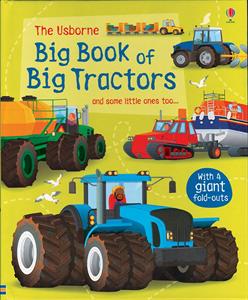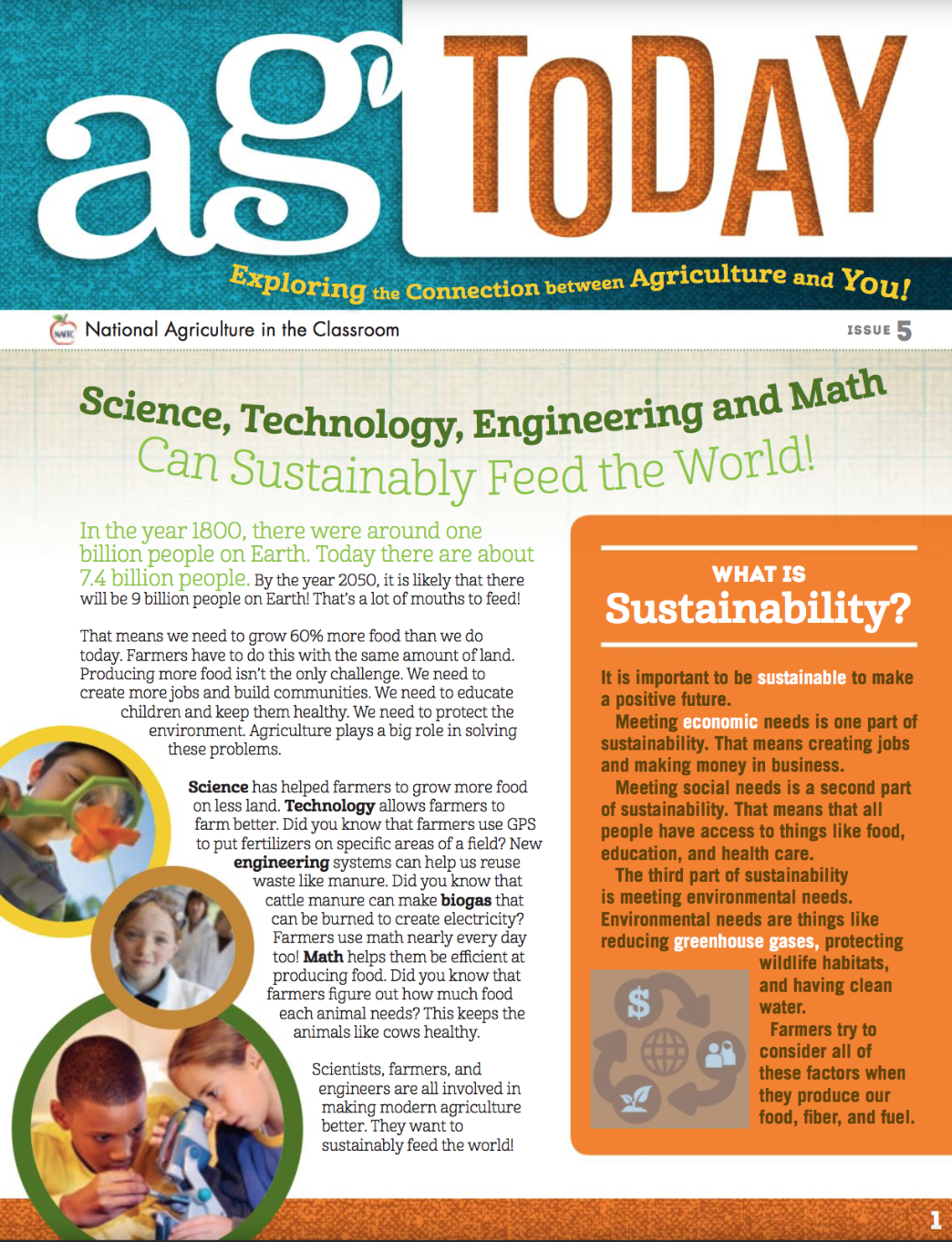Lesson Plan
Machines in Agriculture
Grade Level
Purpose
Students make connections between the six types of simple machines and the complex machinery used to produce food and fiber. Grades 3-5
Estimated Time
Materials Needed
Engage:
Activity 1: A Tractor is a Machine
- Small (half pint) milk carton
- Brown construction paper
- Scissors
- Glue and/or scotch tape
- 3 straws
- Black pipe cleaner
- Modeling clay
- Tag board
- Markers, colored pencils, or watercolor paints
Activity 2: Farm Landscape Flip Book
- Flip Book activity sheet
Activity 3: Machine Advertisement
- Markers, 1 set per group
- Large pieces of butcher paper, 1 piece per group
- Pictures or toy models of farm equipment, 1 per group
Activity 4: Tractor Cinquain
- Writing a Cinquain activity sheet
- Tractor Cinquain activity sheet
Activity 5: Semantic Map
- Semantic Map activity sheet
Vocabulary
agriculture: the science or practice of farming, including cultivation of the soil for the growing of crops and the rearing of animals to provide food, wool, and other products
equipment: supplies or tools needed for a special purpose
machine: an apparatus using or applying mechanical power and having several parts, each with a definite function and together performing a particular task; a device used to help make work easier
tractor: a complex piece of farm equipment; usually used with an implement attached to the back
work: a force applied over distance causing the movement or displacement of an object
Background Agricultural Connections
This lesson is part of a series called, Simple and Complex Machines Used in Agriculture. These lessons introduce students to the simple and complex machines used in their daily lives and in food and fiber production. Through a variety of hands-on activities, students create models of the six types of simple machines and discover the concepts of force and friction. The essential role of complex machines in people's daily lives and in agriculture is interwoven through a number of class and homework activities that incorporate cooperative learning, writing, mathematics, art, and drama. Together these activities are designed to stimulate creative thinking and motivate learning. Other related lessons include:
- Machines and People
- Six Kinds Do It All
- Made to Move
- Machines in Agriculture
The development of agricultural implements has not only made work easier for the farmer, but advanced technology continues to make the machines more efficient. Regardless of the complexity of the machinery, all of the parts of agricultural machinery consist of variations of the six kinds of simple machines.
The overall number of farmers has decreased over the years. Approximately 85% of our population were ranchers and farmers when our nation was formed. Today, only 1-2% of the population is in production agriculture, growing the food and fiber for everyone.
 Animal and plant by-products play an important role in technology. For example, many plastic parts of machinery contain fats and fatty acids from cattle. Rubber tires may contain fats, fatty acids, and stearic acid from animals. Walnut shells are used as an abrasive in sandpaper and put into snow tires to increase friction. Animal manure and corn and rice by-products are used as energy sources to run agricultural equipment. As your students complete these activities, encourage them to think about the interconnectedness of science, agriculture, the environment, and quality of life.
Animal and plant by-products play an important role in technology. For example, many plastic parts of machinery contain fats and fatty acids from cattle. Rubber tires may contain fats, fatty acids, and stearic acid from animals. Walnut shells are used as an abrasive in sandpaper and put into snow tires to increase friction. Animal manure and corn and rice by-products are used as energy sources to run agricultural equipment. As your students complete these activities, encourage them to think about the interconnectedness of science, agriculture, the environment, and quality of life.
"But machines mean much more to us than just easing our daily burden. The really significant thing about a machine is not that it allows a man to do a given job in half the time, but that it can also allow a man to produce twice as much in a given time."
Henry Ford II
Engage
 Read Big Book of Big Tractors by Lisa Jane Gillespie.
Read Big Book of Big Tractors by Lisa Jane Gillespie.- As you read the book, use the illustrations to show students examples of tractors and other farm equipment. Help students make connections as you read. For example, a plow breaks up the soil to prepare it for planting. Ask students, "What kind of foods grow in the soil?"
- After reading the book inform your students that they are going to be learning about how machines help farmers grow and produce the food we eat and the fiber that makes our clothes and other fabrics.
Explore and Explain
Activity 1: A Tractor is a Machine
 Each student needs the following materials to make a tractor:
Each student needs the following materials to make a tractor:
- Milk carton (1 small)
- Brown construction paper to cover the milk carton
- Tag board for wheels and headlights
- Straws (3)
- Scissors
- Black pipe cleaner (1)
- Glue and/or tape
- Modeling clay
- Markers
- Have the students:
- Cover the milk carton with brown construction paper using glue or tape. Use the tag board to cut out two large circles for wheels. Decorate the wheels using the markers or crayons. Cut out two headlights. Glue the headlights to the front of the tractor.
- Poke two holes with a pencil in the top of the tractor, one near the front and one close to the back. Cut a section of a straw, and put it into the hole near the front. With the pipe cleaner, fashion a steering wheel and column and put that into the other hole. Use glue or a dab of modeling clay to hold the parts in place so they do not slip through the holes.
- On either side of the tractor, poke holes where the axles should go for the front and rear wheels. Use straws as axles and poke them through the tractor at the appropriate places.
- Poke a hole through the center of each wheel. Put the wheels on either side of the tractor where the axles protrude. Use modeling clay to hold the wheels in place on the axle. This will keep the wheels on the axles, but will allow the axles to turn.
- Challenge the students to exercise their inventive nature by providing a variety of other materials and giving them the opportunity to add an implement to the front or back of their tractor. They must be able to explain what simple machine this implement employs and what job it does to make work easier for the farmer.
Activity 2: Farm Landscape Flip Book
- Distribute the Flip Book activity sheet and ask students to draw a piece of farm equipment on each of the ten pages. They may also draw a farm landscape. Each drawing should be done in such a way as to portray a sequence like series of frames in a movie film. The short vertical lines at the bottom of each page may serve as guidelines as the drawing progresses from frame to frame. For example, on page one, the tractor might be on the far left side of the page. The sun might be in the middle of the sky and perhaps some birds in the sky. As each succeeding page is drawn, the details of the scene change slightly to show movement.
- When the drawings are complete, instruct the students to cut out the pages and staple them together in the margin allowed. If the drawing on each page is done in sequence like a series of frames in a movie, the objects will move when the pages are flipped quickly with the thumb. Thus, the sun and birds will seem to move across the sky and the tractor will plow or harvest a field.
Activity 3: Machine Advertisement
- Review with your students your rules for cooperative group activities.
- Place students in groups of three or four. Give each group a set of markers, a large piece of butcher paper, and a toy model or picture of a piece of farming equipment.
- Explain to the students that they are going to create an advertisement for this machine. They must make it appealing and interesting so a farmer will consider purchasing the equipment.
- Have a class discussion about what should be included in the advertisement. Write the ideas on the board. Some suggestions might be:
- A list and labeling of the simple machines it contains.
- A drawing and the name of the machine.
- An explanation of its use:
- Preparing the soil
- Planting the crop
- Maintaining the crop
- Harvesting the crop
- Livestock management/transportation
- A description of commodities it is used for.
- An approximate cost and where it can be purchased.
- Prior to making the final advertisement, require students to proof their work for proper spelling and grammar, including sentence structure, punctuation, and capitalization.
- Have the students create their advertisements and share them with the class. Create a bulletin board display or catalog of the student work.
Activity 4: Tractor Cinquain
- Have your students use the Writing a Cinquain activity sheet to create a tractor cinquain.
- After the students have proofed their tractor cinquains, have them rewrite their work onto the Tractor Cinquain diagram. Cut out the tractors and display them on a bulletin board or on a piece of butcher paper designed as a field.
Activity 5: Semantic Map
- The purpose of this activity is for the students to use the concepts they have learned to write about four specific ideas related to agricultural machines. An important aspect of this activity is the discussion that takes place.
- Project a copy of the Semantic Map activity sheet onto a large screen. Have the students suggest words, thoughts, and ideas that fit each category.
- After some discussion, pass out a Semantic Map activity sheet to each student, and let the students work on their own. You may want to designate a certain number of ideas they must write in each section.
- When they are finished, collect the work and use it as an assessment tool.
Elaborate
-
Invite a farm equipment mechanic to your classroom to share information about farming equipment. Have this person discuss how pieces of equipment are used and how farm equipment has changed over the years.
-
Divide the students into groups of five or six. Give each group a picture of a machine or let them come to a consensus on a machine. Have each group make this machine with their bodies and demonstrate their human machine to the other groups. Encourage the use of movement and sound. Have the others guess what the machine is, some simple machines it contains, and what it is used for.
-
Have groups of students sort and classify agricultural equipment pictures into six categories—preparing the soil, planting the crop, maintaining the crop, harvesting the crop, livestock management, and transportation of a crop or livestock.
-
Play the My American Farm interactive game Equipment Engineer.
-
 Read Issue 5 of Ag Today titled Agriculture in Society. This reader can be accessed digitally. Students will learn the term sustainability and what that means to farmers who need to produce 60% more food with the same amount of land in order to feed a growing world population. Learn what byproducts are and how they are used, how food packaging has decreased waste, and how farmers use technology such as various tools, robots, and hand-held devices to improve their efficiency.
Read Issue 5 of Ag Today titled Agriculture in Society. This reader can be accessed digitally. Students will learn the term sustainability and what that means to farmers who need to produce 60% more food with the same amount of land in order to feed a growing world population. Learn what byproducts are and how they are used, how food packaging has decreased waste, and how farmers use technology such as various tools, robots, and hand-held devices to improve their efficiency.
Evaluate
After conducting these activities, review and summarize the following key concepts:
- The invention of the tractor, plow, and other agricultural machines has revolutionized a farmer's ability to produce food and fiber.
- The use of machines allows farmers to produce more food and fiber with less physical labor.
- The use of machines and technology helps conserve natural resources such as water and fertilizer. Specialized machines have sensors that know exactly when and where water and fertilizer is needed.
Acknowledgements
This lesson was funded in 1996 by the California Beef Council and the California Farm Bureau Federation. To meet the needs of California educators, Simple and Complex Machines Used in Agriculture was revised to support the Curriculum Content Standards for California Public Schools and updated to include recent agricultural innovations. Funding from the Wells Fargo Foundation made this revision possible.
Illustrators: Karin Bakotich, Pat Houk, Sherri Hughes, Regina Johnson
Layout and Design: Nina Danner
Recommended Companion Resources
- A Year on the Farm: with Casey & Friends
- Ag Today
- Big Book of Big Tractors
- Big Tractor
- Big Tractors: with Casey & Friends
- Combines: with Casey & Friends
- Farmall in the Family with Casey & Friends
- Hey, Hey, Hay!
- John Deere's Powerful Idea: The Perfect Plow
- John Deere, That's Who!
- Machines on the Farm
- My American Farm
- Planters and Cultivators: with Casey and Friends
- Simple Machines: Wheels, Levers, and Pulleys
- Time for Cranberries
- Tractor Timeline- A History of Tractors
- Trax the Tractor and His Farming Friends
- Tremendous Tractors
- Up Close Experience: Combines
Author
Organization
| We welcome your feedback! If you have a question about this lesson or would like to report a broken link, please send us an email. If you have used this lesson and are willing to share your experience, we will provide you with a coupon code for 10% off your next purchase at AgClassroomStore. |